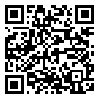Volume 4, Issue 16 (2007)
LIRE 2007, 4(16): 219-238 |
Back to browse issues page
Download citation:
BibTeX | RIS | EndNote | Medlars | ProCite | Reference Manager | RefWorks
Send citation to:



BibTeX | RIS | EndNote | Medlars | ProCite | Reference Manager | RefWorks
Send citation to:
An Analysis of the “Nowhere of Misery”Story in the Masnavi with a focus on Human Crises. LIRE 2007; 4 (16) :219-238
URL: http://lire.modares.ac.ir/article-41-37404-en.html
URL: http://lire.modares.ac.ir/article-41-37404-en.html
Abstract: (2896 Views)
Gorji.M.,PH.D
Abstract:
One of the 260 stories of the Masnavi is a short and untitled tale whose exact source is not known. It comes under the story of the Saba people in Part III. No-one among the exponents has commented on it; some have given only a few hints. They have simply interpreted the symbols or explained the lexical elements. Of course Molavi himself has addressed it later in the story. I believe that none of the researchers and commentators has examined the said tale without attention to Molavi’s own explication or structurally as an independent story. In this paper I try to come up with a new reading of the story. I am of the opinion that all parts of the story must be interpreted as a whole and in a unified context or discourse chain in relation to the preceding stories. Based on this approach, as the story’s structure is analyzed and its elements examined, another interpretation is provided with attention to the problems of contemporary man. This is not seen in any of the previous sources. The said allegoric story owes its special treatment and imagery to the imagination of Molavi. It has its roots in the poet’s stream of consciousness and religious mythology - such as the story of Joseph and the dreams of Egypt’s ruler, and the tale of Abraham and the four birds - as well as in dreamlike surreal images. This relatively short story contains great universal points and messages for lonely human beings who are stranded in the contemporary world. Describing the major potential woes and problems of humans, Molavi explains and analyzes these ills and finally proposes ways of getting rid of them.
Keywords: Key words: human crises, the Nowhere of Misery, structural analysis, Masnavi, interpretation
Article Type: مقالات علمی پژوهشی |
Subject:
Classical literature
Received: 2019/10/15 | Accepted: 2019/10/15 | Published: 2019/10/15
Received: 2019/10/15 | Accepted: 2019/10/15 | Published: 2019/10/15
| Rights and permissions | |
 |
This work is licensed under a Creative Commons Attribution-NonCommercial 4.0 International License. |






